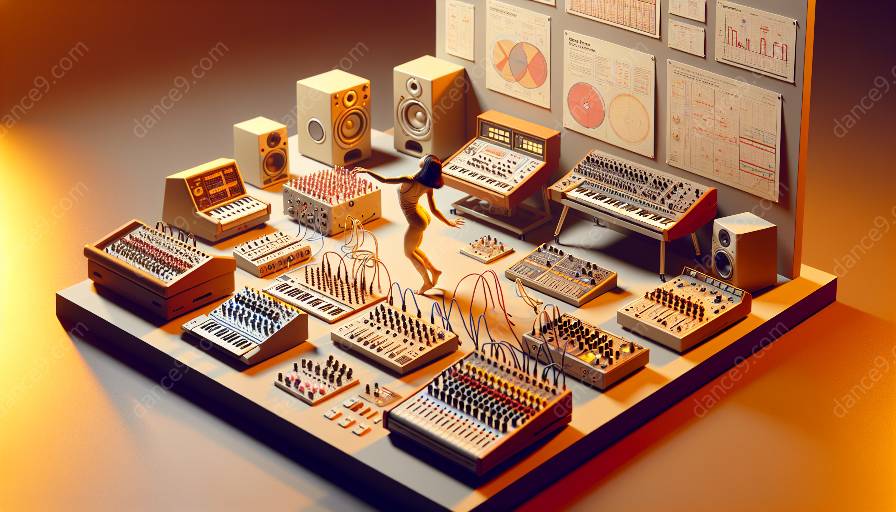Electronic music production has revolutionized the music industry, providing an array of tools and technologies to create captivating and dance-worthy tracks. Among these tools, samplers play a crucial role in shaping the sound and feel of electronic music. When used effectively, samplers can elevate dance performances and enhance the overall production quality.
Implementing samplers in electronic music production for dance performances requires a deep understanding of the equipment used in dance and electronic music production, as well as the intricacies of dance and electronic music. This topic cluster will explore best practices for using samplers in electronic music production to create enthralling dance performances, while considering the relevant equipment and the characteristics of dance and electronic music.
Understanding Samplers in Electronic Music Production
Before delving into the best practices, it's essential to understand what samplers are and how they function within electronic music production. Samplers are electronic devices or software instruments that can capture and manipulate sound samples. These samples can be recordings of instruments, vocals, or any other sound, which can then be manipulated, processed, and played back in various ways.
In dance and electronic music production, samplers are used to create rhythmic and melodic patterns, as well as to incorporate unique and unconventional sounds into a track. They serve as a key tool for producers to craft engaging and danceable music that holds the audience's attention.
Choosing the Right Samplers
One of the first steps in implementing samplers effectively is selecting the appropriate tools for the job. With the wide range of hardware and software samplers available, understanding the specific needs of dance and electronic music production is crucial. Factors to consider when choosing samplers include sound quality, ease of use, compatibility with other equipment, and versatility in terms of sound manipulation and performance capabilities.
Several popular hardware samplers, such as the Akai MPC series and Elektron Octatrack, are renowned for their tactile interfaces and unique sonic character. On the software side, samplers like Native Instruments Kontakt and Ableton Simpler offer extensive sound libraries and intuitive user interfaces for electronic music producers.
Integration with Sequencers and DAWs
Integrating samplers with sequencers and digital audio workstations (DAWs) is essential for creating cohesive and dynamic electronic music productions. Seamlessly incorporating samplers with the production workflow allows for rapid experimentation and creative exploration.
Most modern samplers are designed to integrate seamlessly with popular DAWs such as Ableton Live, FL Studio, and Logic Pro, enabling producers to trigger and manipulate samples in real time while synchronizing with the rest of the production. This integration enhances the live performance aspect of electronic music, making it suitable for captivating dance performances.
Utilizing Sampling Techniques
Sampling techniques play a pivotal role in crafting unique sounds and textures in electronic music production. While basic sampling involves capturing and playing back audio snippets, advanced techniques such as time stretching, slicing, and granular synthesis can take electronic music to new heights.
In dance music, rhythmic sampling techniques such as chopping up drum breaks and vocal phrases can add energy and excitement to the tracks. Additionally, utilizing seamless looping and crossfading techniques allows for creating seamless transitions and evolving soundscapes that captivate the audience on the dance floor.
Playing and Performing with Samplers
From live performances to studio sessions, the performance aspect of using samplers in electronic music production is crucial for captivating dance audiences. Understanding the nuances of playing and performing with samplers can significantly elevate the overall impact of dance and electronic music productions.
Performing with samplers involves triggering and manipulating samples in real time, adding expressive gestures and variations to the music. This live interaction with the samplers injects an element of spontaneity and excitement into the performance, resonating with the energy of dance music performances.
Relevance to Dance and Electronic Music Equipment
The best practices for implementing samplers in electronic music production are closely tied to the equipment used in dance and electronic music, including synthesizers, drum machines, effects processors, and controllers. Understanding how samplers complement and interact with this equipment is essential for creating cohesive and impactful dance performances.
Samplers often integrate seamlessly with synthesizers and drum machines, allowing producers to create cohesive and intricate arrangements that drive the dance floor. Additionally, pairing samplers with effects processors and controllers enhances the sonic palette and performance capabilities, adding depth and dynamics to electronic music productions.
Captivating Dance Performances with Effective Samplers
Implementing samplers in electronic music production for captivating dance performances is a multifaceted process that requires a holistic approach. By understanding the intricacies of samplers, choosing the right tools, integrating them effectively within the production workflow, utilizing advanced sampling techniques, and embracing the performance aspect, producers can elevate their dance music productions to create truly immersive and enthralling experiences.
Overall, the best practices for implementing samplers in electronic music production for captivating dance performances are deeply intertwined with the equipment used in dance and electronic music. By exploring and mastering these practices, electronic music producers can create dynamic and infectious tracks that resonate with dance audiences worldwide.
From hardware samplers to software instruments, from sampling techniques to live performances, the realm of samplers in electronic music production offers a vast and exciting playground for producers to explore. With the right knowledge and skills, producers can harness the power of samplers to craft compelling dance tracks that leave a lasting impression on both the dance floor and the electronic music landscape.






























